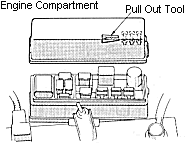Checking and Replacing Fuses



If the headlights or other electrical components do not work, check the fuses. If any of the fuses are blown, they must be replaced.
See Fuse and Circuit Breaker Locations for locations of the fuses.
Turn the ignition switch and inoperative component off. Pull a suspected fuse straight out and check it.
Determine which fuse may be causing the proble. The lid of the fuse boxes show the name of the circuit for each fuse. See Part 8 of this manual for the functions controlled by each circuit.
Type A fuses pull out by using the pullout tool.
If you are not sure whether the fuse has blown, try replacing it with one that you know is good.
If the fuse has blown, push a new fuse into the clip.
Install only a fuse with an amperage rating designated on the fuse box lid.
If you do not have a spare fuse, in an emergency, you could pull out the "CIG", "RADIO" or "DOME" fuse, which may be dispensable for normal driving, and use it if its amperage rating is the same.
If you cannot use one of the same amperage, use one that is lower, but as close as posible, to the rating. If the amperage is lower than that specified, the fuse might blow out again, but this does not indicate that anything is wrong. Be sure to get a correct fuse as soon as possible, and return the substitute to its original clip.
It is a good idea to purchase a set of spare fuses, and keep them in your vehicle for emergencies.
If the new fuse immediately blows out, there is a problem with the electrical system. Have your Toyota dealer correct it as soon as possible.
| CAUTION:
Never use a fuse with a higher amperage rating or any other object in place of a fuse. This may cause extensive damage and possibly a fire. |